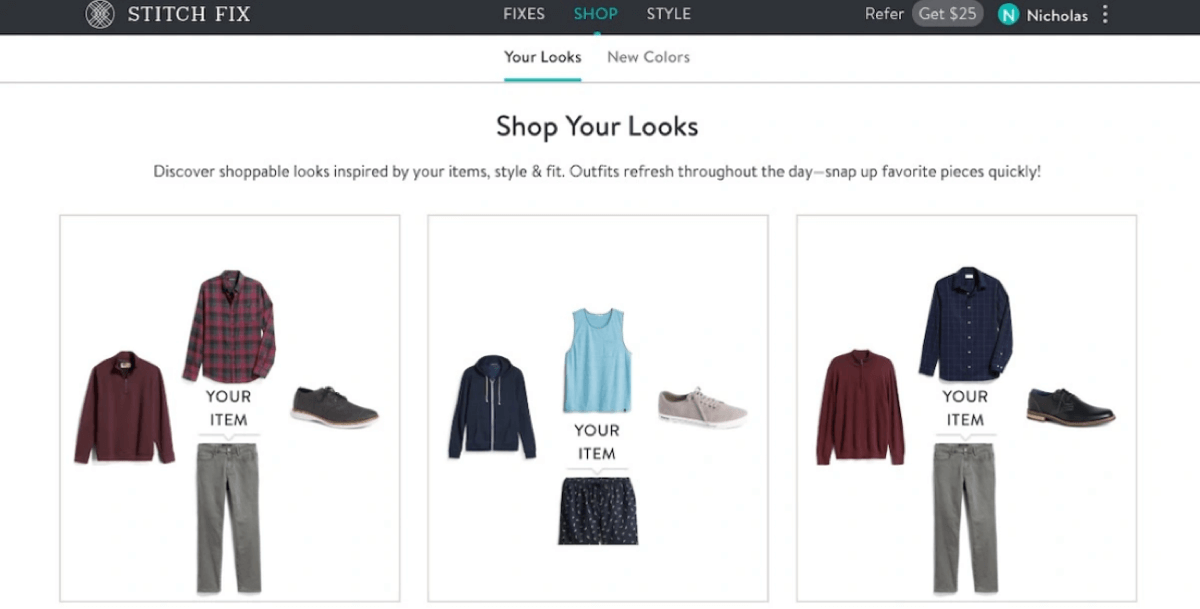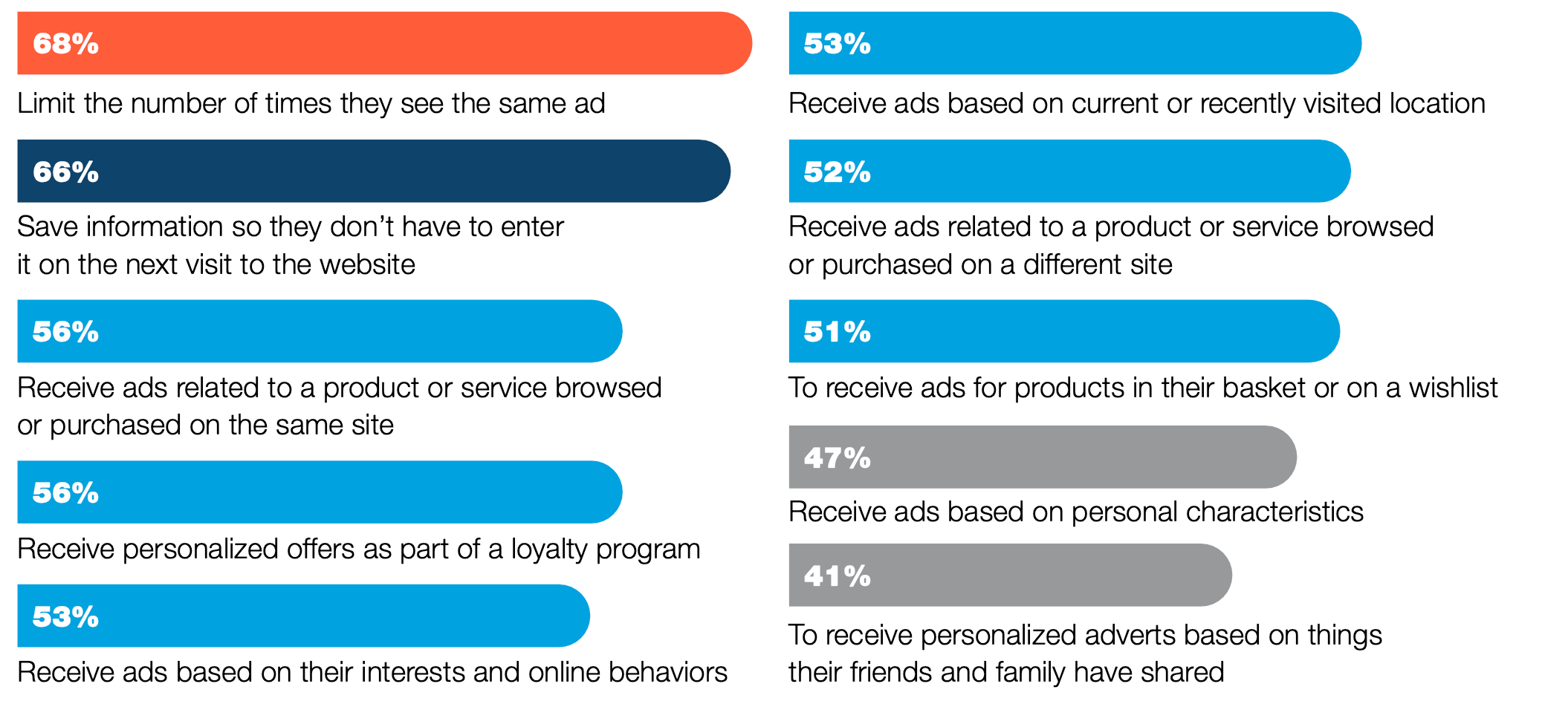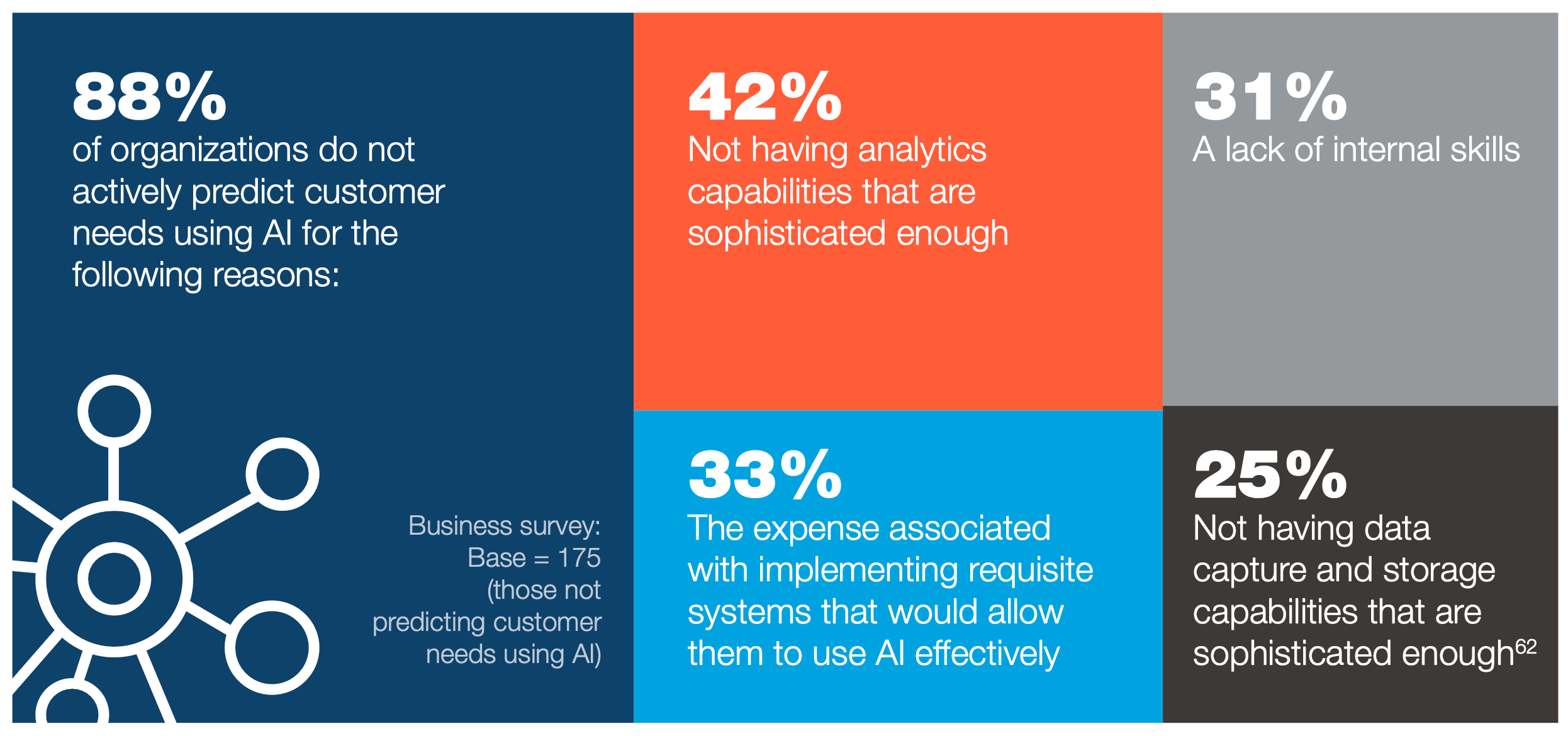Are You Ready for Marketing Made Better?
We can help you understand your customers, stay ahead of regulations, and grow your business.
A cutting-edge advertising technique that uses AI to predict what people will want.
Consumers increasingly expect personalized brand experiences. Whether it’s marketing communications or in‐store, online, and in‐app experiences, they value interactions that are tailored to their unique context and preferences. Just over half (51%) the consumers we surveyed say they like it when companies recommend products and services that are tailored to their personal preferences56.
Brands are acknowledging this expectation and are shifting away from broad-brush demographic or market-based segmentation alone, instead taking a more holistic approach that favors more individualized CX strategies that use customer data to deliver relevant experiences. Predictive personalization is the next step in this process.
Generative AI is supercharging personalization, enabling businesses to create customized experiences at unprecedented scale and precision. Generative AI can use behavioral patterns and individual characteristics to learn what customers might do or want next. In this way, personalization evolves from recommendations based on a static view of past behavior, to predicting how customers’ needs and tastes will evolve moving forward.
But predictive personalization is a complex undertaking. To use it effectively, brands need to take a data-led approach, building a deep understanding of customers’ changing wants and needs, and employing sophisticated ML models to act on that information.
In 2024, leading brands will embrace predictive personalization as a strategic imperative, using their valuable first-party data to deliver more engaging and relevant CX.
Case Study

Stitch Fix is a personal styling service. On signup, customers complete a detailed profile including their measurements, body type, likes and dislikes, personality traits, lifestyle, and budget. Stitch Fix’s AI algorithms then combine this information with additional data to curate a personalized selection of clothing items.
The Stitch Fix AI algorithms are constantly learning. They are trained on a massive dataset including purchase history, customer reviews, and social media activity to better understand style preferences. This means Stitch Fix can predict, with a high degree of accuracy, which pieces a particular customer will like, and how their preferences may evolve over time.
Stitch Fix’s AI algorithms help to improve the overall customer experience in other ways, such as:
Stitch Fix’s use of AI to predict what customers will want has helped the company become one of the world’s leading personal styling services. Its unique approach results in higher customer satisfaction, improved conversion rates, reduced returns, and increased brand loyalty.
Consumer perspective:
Consumers respond positively to personalized advertising. In fact, nearly half (47%) of the people we surveyed said they are more likely to click on an advert or email if it contains personalized content, including offers57.
What’s more, around half feel providing their data to brands is worthwhile if they receive ads based on their interests and online behaviors (53%), location (53%), and personal characteristics (47%), or if they receive personalized offers as part of a loyalty program (56%)58.
When asked about the useful ways in which a company may use online information, the people in our survey ranked the following59:
Useful ways in which a company may use customer data (% agreed)

Given people already want brands to talk to them in a way that feels relevant to their unique context, predictive personalization is the natural next step. Predictive recommendations have several benefits for consumers:
Convenient shopping experiences: Over half (57%) the people we surveyed said personalized ads and recommendations help them find relevant products and services more easily60.
More relevant advertising: When brands use predictive personalization, people are less likely to be bombarded with irrelevant ads.
Improved decision‐making: Predictive personalization helps people make better decisions. For example, a financial services company can use it to recommend investment products based on a customer’s risk tolerance and financial goals.
Business perspective:
By predicting preferences and needs, brands can bring customers the products and services they want, before they’re even aware they want them. This takes personalization to an entirely new level. AI-enabled predictive personalization allows tailored content to be delivered at scale across a broad array of marketing and customer engagement content, including adverts, articles, product images, videos, emails, and offers.
When customers feel more understood and enjoy the convenience of having their needs pre-empted, the results are likely to be increased engagement, satisfaction, and loyalty, ultimately resulting in a higher LTV.
“We are leveraging AI to surface products, to our newly acquired customers, that we know are likely to be bought on the second purchase. So for example, when people buy an Adidas sweater, they might buy a Nike top as well. The data is really strong showing that this encourages a second purchase.”
Head of Performance Marketing, fashion retailer
And, with the emergence of publicly available generative AI applications democratizing access to big data processing, predictive personalization is now more accessible than ever before.
But despite this, predictive personalization is still largely the preserve of tech-savvy, digital-first organizations. Only 12% of the organizations we surveyed actively predict customer needs using AI at the current time61. This means there is a huge opportunity for brands to adopt predictive personalization and gain a competitive advantage.

Our survey also showed that not all brands are aware of all predictive personalization strategies, and even fewer are currently implementing them.


Business survey: Base for first column = 200, inset second column is the % of brands that are deploying among those who are already aware of different personalization strategies
Making it work:
To infuse AI and decisioning into their data strategies to power predictive personalization, brands must first unify their customer data across first- and third-party platforms to form a single customer view. This view must be updated in real-time to reflect the latest customer interactions and capture evolving customer preferences. CDPs are the ideal technology to achieve this goal, but they will also require a complementary identity solution to reconcile the disparate data that pertains to an individual.
In addition to bringing together high volumes of customer data, brands must also ensure they have the analytics capabilities to process it. Predictive models will need to analyze data from a range of platforms and channels to identify patterns and trends that can be used to predict customer behavior65.
Finally, businesses need to have the in-house expertise to develop and deploy AI recommendation algorithms that can recommend products and services that are likely to be of interest to individuals.
In addition to these considerations, businesses must also prioritize data privacy and security. 61% of the consumers we surveyed say receiving personalized ads and recommendations makes them concerned about how their data is used and shared66.
With data privacy top-of-mind for consumers, brands must ensure customer data is not compromised by third-party AI integrations and applications.
Overall, predictive personalization will require brands to think differently about the types of data they collect, how they entice customers to share it, and how they bring it together.
Predictive personalization will impact all industries. Right now it’s often about movie recommendations on streaming services. But in the future it might be used in healthcare, with doctors relying on predictive personalization to recommend treatments based on the patient’s individual medical history and risk factors.
In 2024, we’ll see greater awareness and uptake of predictive personalization, leading to increasingly advanced use cases across an expanding range of verticals. However, this will require investments in the collection, unification, and activation of customer data.
We expect to see investment in tech that enables businesses to gain a single customer view, advance their personalization capabilities, and deliver predictive personalization at scale. We’ll also see a broadening of generative AI usage to create customized content cost-efficiently. This includes the use of AI-generated models to develop individualized offers and pricing tiers, create personalized emails, and generate product images that are contextually relevant to individual customers.
Crucially, businesses will need to consider how to encourage their customers to share the data needed to power predictive
personalization. People are increasingly aware of the value of their data and view sharing it as a transaction – they will share, but they want to get something in return.
Acxiom’s responsible marketing survey reveals the top two most acceptable and useful applications of data in online advertising are showing ads based on interests and showing ads based on products previously browsed or purchased. Brands will need to be thoughtful about delivering predictive personalization in the right moments and in a way that feels helpful to the individual.
While delivering on the promise of predictive personalization may require significant upfront investment, businesses that get it right will enjoy increased customer engagement and improved customer satisfaction and loyalty that will translate into revenue growth in 2024 and beyond.
We can help you understand your customers, stay ahead of regulations, and grow your business.